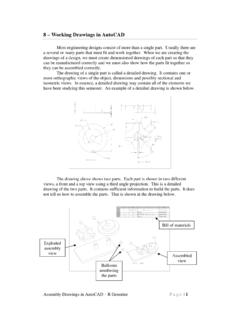Transcription of Instructions for the ‘Life Map’ Exercise and Telling Your ...
1 Instructions for the Life Map' Exercise and Telling Your Story Developed by Robert Clinton; adapted by Steve Miller, Myles Lorenzen and Nathan Shattuck Psalm 107:2 Let the people redeemed by God tell their story . Note: The Lifemap is an Exercise that I'd like you to take some time in the next few weeks to put together. I'd suggest working on it in at least two separate sittings, asking God to reveal any shaping people, places, experiences or influences that might not be readily accessible the first time you sit down to do this. Then, using your Lifemap we'll have a session(s) where you'll tell me your life story' from your childhood through to the present. The Lifemap is simply a tool, a framework within which to explore the many different factors that have shaped who and where you are today. In many ways these factors powerfully influence the way we feel, how we relate to others (including God), and how we interpret and even experience the ways others relate to us.
2 Besides it being a personally powerful Exercise that most people unfortunately never experience even once, for my role in facilitating God's work in your heart accelerates the process of gathering the data' of your life and heart to focus our time on the areas that are most likely to bring you growth and freedom. In addition there is also power in Telling your story to another. I have done this 4-5 times myself in different contexts, finding that each time for me has been a significant experience of God's continuing revelation of what shaped and misshaped me and his continuing redemption of who I. am. I believe it can be that for you as well. While everyone's journey will be unique, in my experience at Soul Care it's not been unusual for God to use the often uneasy experience of creating their Lifemap, followed by our sessions exploring it together, as the transformational turning point for many of those I've counseled over the years.
3 And remember, as in most things we get out of them what we put into them - I hope you will put your heart into this, your own story. Nathan Shattuck Additional Preliminary Instructions : Once you have your Lifemap put together, we'll have a session (usually a few sessions after your Initial Session - to give you time to do the Exercise without having to rush it) where you'll bring your Lifemap with you and use it as a guide to walk me through the journey of your life. If married (often even if the spouse isn't part of our counseling process), it's best if both of you can be present, because hearing the Lifemap can help them know and understand more of where you're coming from as a person and hopefully be less likely to misunderstand your motivation than they did Nathan Shattuck before knowing the context of your life story with the degree of depth the Lifemap often results in.
4 But there are times where, for specific reasons, a spouse would prefer to have the Lifemap session(s) alone or to go through it without their spouse before doing so with their spouse present. Also, for some people going through their Lifemap is a single session, but on rare occasions for a few that's even taken up to 7 sessions so, because each of our stories is so unique and this is a process where we are being led by the Holy Spirit, there's no rhyme or pattern on how it should be done or what it's supposed to look like. And the Instructions in this document are suggestions - if there's a way of doing it that feels more you, that's fine, be as creative and flexible as you feel led to. Some people end up with what looks more like an art project which really expresses their heart and experience of life and others bring in (I'm not kidding), an Excel spreadsheet that looks more like a flow chart, but which expresses their particular heart and story just as well.
5 It's important on your Lifemap to not hurry to get it done - just take some time and work on it and see how many times of focusing on it it takes for you to feel like it's somewhat complete (not every detail exactly or totally comprehensive, just a good picture of your life and the people, places and experiences that have shaped you). One last important thing that can be good to help us remember (especially with things that may be significant but aren't a memory that's just sitting there on the surface all the time) is if you can get as many pictures from throughout your life (most people have to get these from their parent's ) and look through them. Through the pictures, look back at the different stages, people, phases, braces!, etc. of your life that may have faded into the background over the years and reaquaint yourself a bit with the boy or girl that was you back in those formative, vulnerable years.
6 Also, if you don't mind, bring a few of those pictures with you to the session when we go through your Lifemap - pictures that are representative of the different stages in your life or if there are any pictures that feel particularly significant to you (positively, negatively or that just bring up some emotion). 1. Supplies Needed: Get 1 sheet of white construction paper and 2 stacks of small or medium size Post-It notes . each stack of a different color ( , 1 of yellow Post-It notes and the other of blue Post-It notes). Taping sheets of printer paper or manila folders together or cutting out the side of a cardboard box also works as the background, but it can be a little harder to keep everything together while transporting to my office and back if the background is too flimsy. 2. Start the Lifemap Exercise by just Brainstorming About Your Life History: Take the pad of yellow Post-It notes and brainstorm on the people, places and events that have shaped your life (write only one of these per post-it note).
7 Jot down just a few words on each post-it note to capture the idea. Let the ideas flow as a stream of consciousness . Note: At this point, don't worry about any particular order or sequence, just sit down with the stack of yellow Post-It notes and try to get as many as possible out; especially those in your younger years which may be less easily remembered but also the most influential in shaping you. Nathan Shattuck Some questions to prime the pump: What might you share about yourself to a friendly stranger on a long plane ride? People Places ( , geographic locations, houses lived in, etc.). Events (include any before you were born that significantly shaped the emotional, relational environment you were born into). Education, Job's, Ministries, Hobbies and Interests Your Process of Salvation What would you share about yourself with a dear and trusted friend?
8 Successes what has delighted you the most in your life? Failures what has disappointed you the most in your life? Were there major personality, mood, relational shifts in you at any point? On these next two, think of those things you have done as well as those things that have happened to you or around you: Joys - what have been the people, places or events in your life that have been most positive and/or about which you are most proud/happy when you recall them? Sorrows what have been your deepest hurt(s) and disappointments? 3. Arrange the notes in a logical sequence in the columns of the big sheet (see drawing below). Most people arrange their notes in chronological order from left to right, some using different columns by segments in school or life stages, or different addresses or cities they lived in, etc. But you can do it in whatever order or segments feels most natural for arranging your story.
9 ** Note: Ignore the rows at the bottom on the drawings, for the sake of time and simplicity we won't be doing that part of this Exercise . Nathan Shattuck 4. Use the pad of different colored post-it notes to highlight the painful people, places and events. Transfer the words/names/events on the original painful yellow note to one that is of a different color. This causes the groupings or stages of your life with more pleasant or painful notes to stand out from each other. ** Again, take your time and add additional notes of the appropriate color (for negative or positive, pleasant or painful) as you recall other people, places and events. NOTE: Cognitive Beliefs or Biblical Truths are taught, But Deep Beliefs are most often caught (watching other people, especially our parents). Look for Clues as to God's Calling in your Life!
10 And bought in painful experiences, - especially Look back over your emerging timeline for patterns or themes. at early ages where we Ask God to reveal to you, now as you are retrospectively curious' are most impressionable. in looking at your life so far, what He was establishing in your life, Hence, believers can be living even before you came to know Him: lives that violate their sincerely held beliefs and convictions What patterns do you see in the personal inclinations, because they have never pivotal decisions, unique opportunities and transforming confronted and disarmed the experiences of your history? power of their personal Deep Beliefs. What was God uniquely preparing you for, even in painful experiences? Remember, God doesn't waste experiences in our lives. In short, what has God called' you to in your life?








